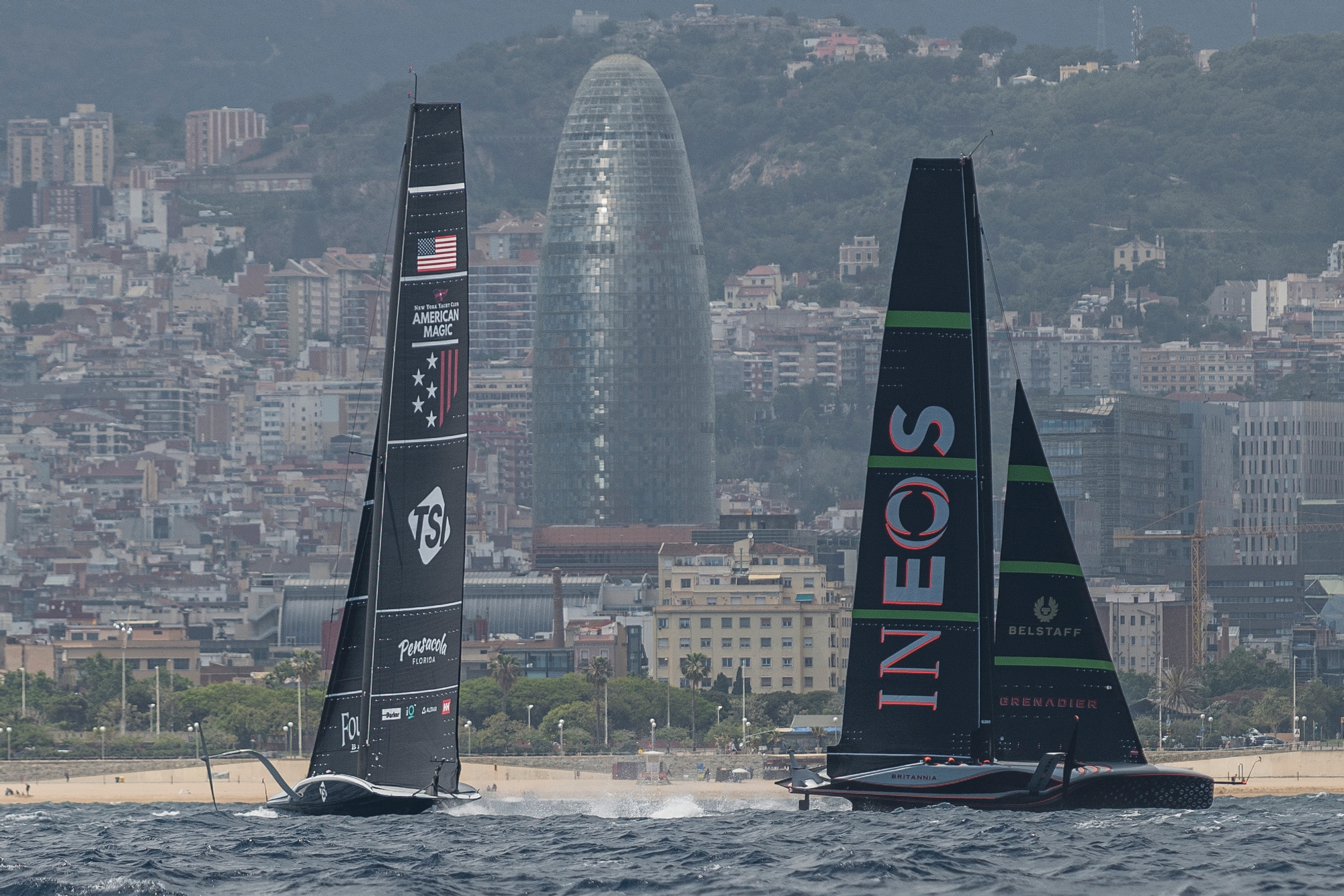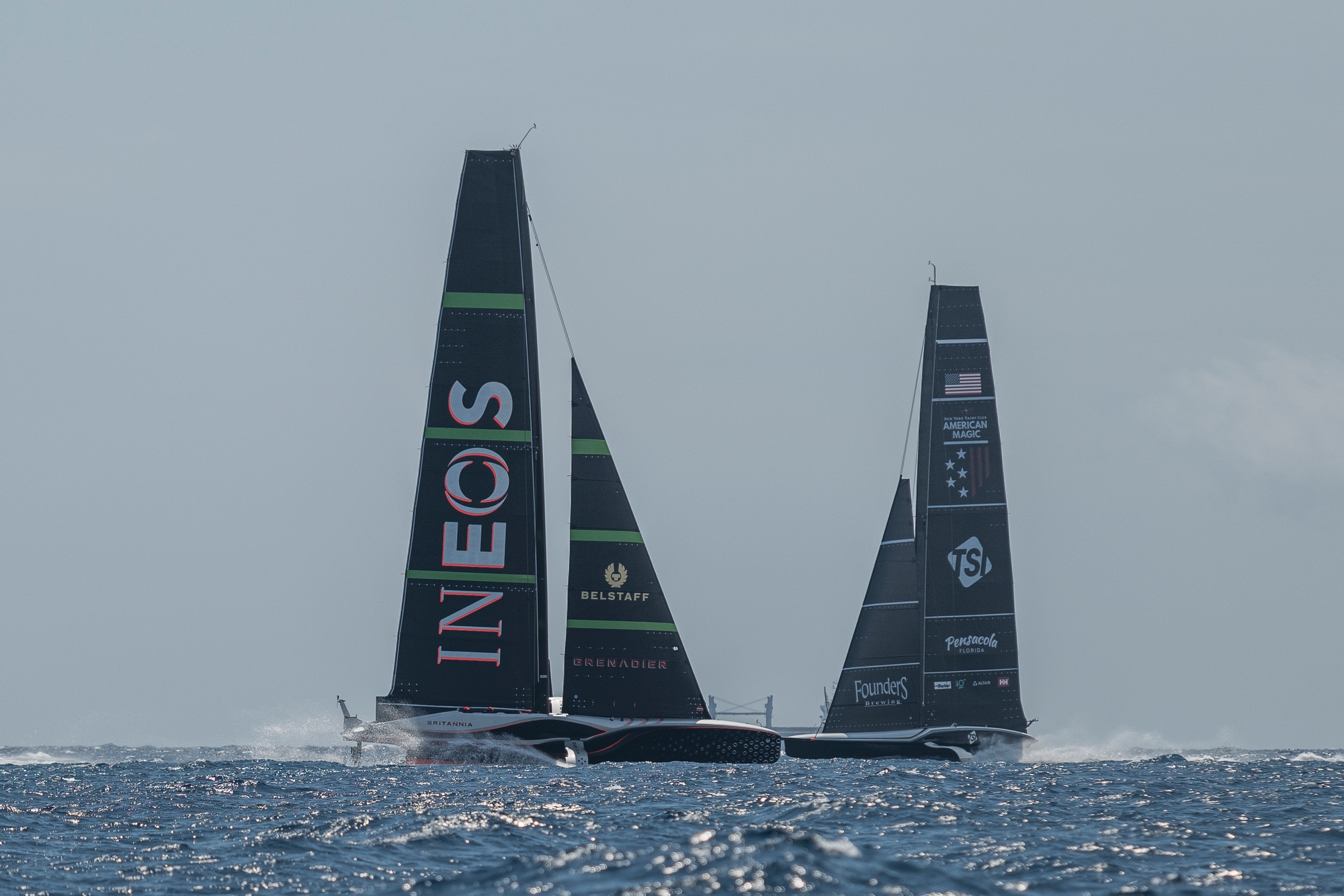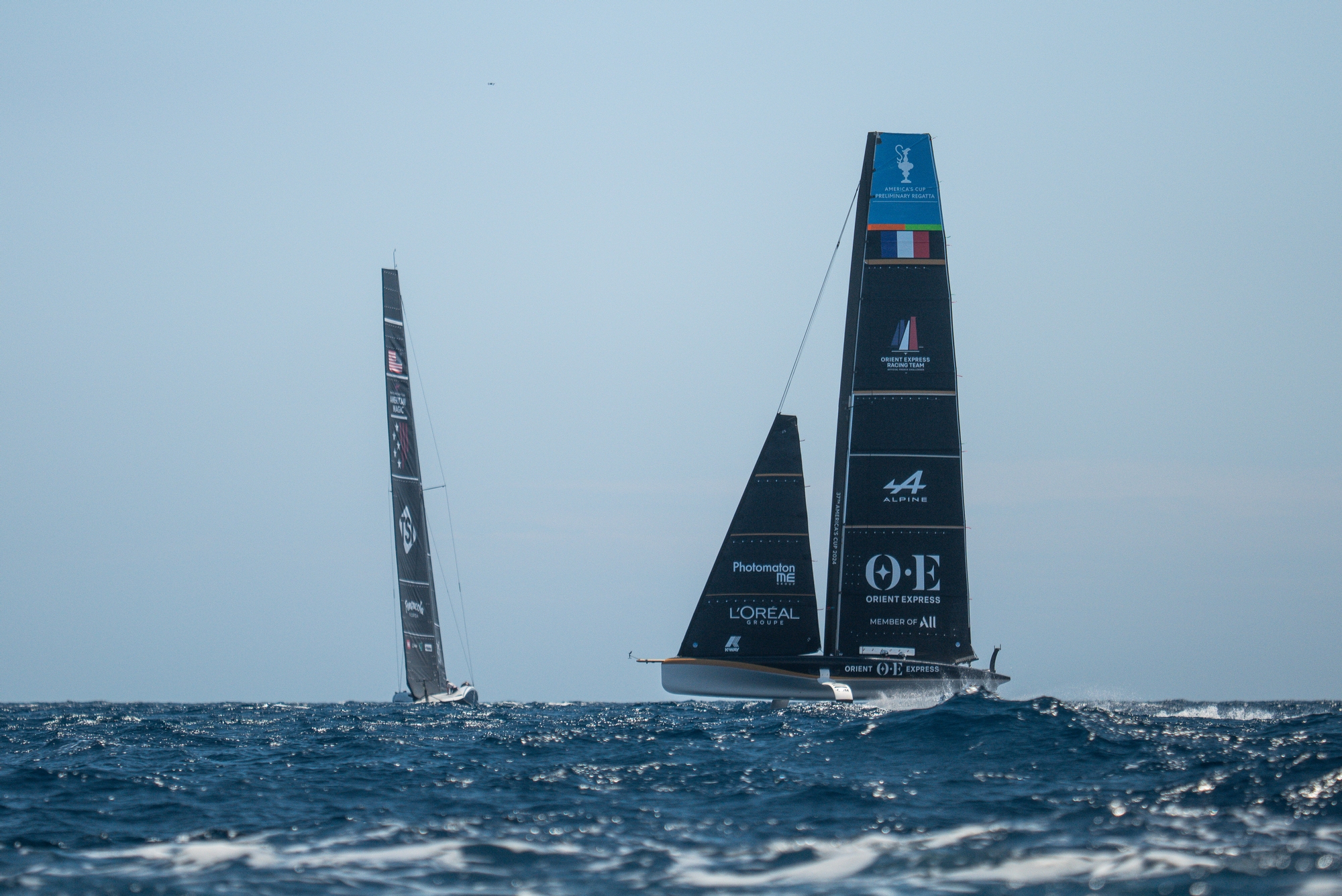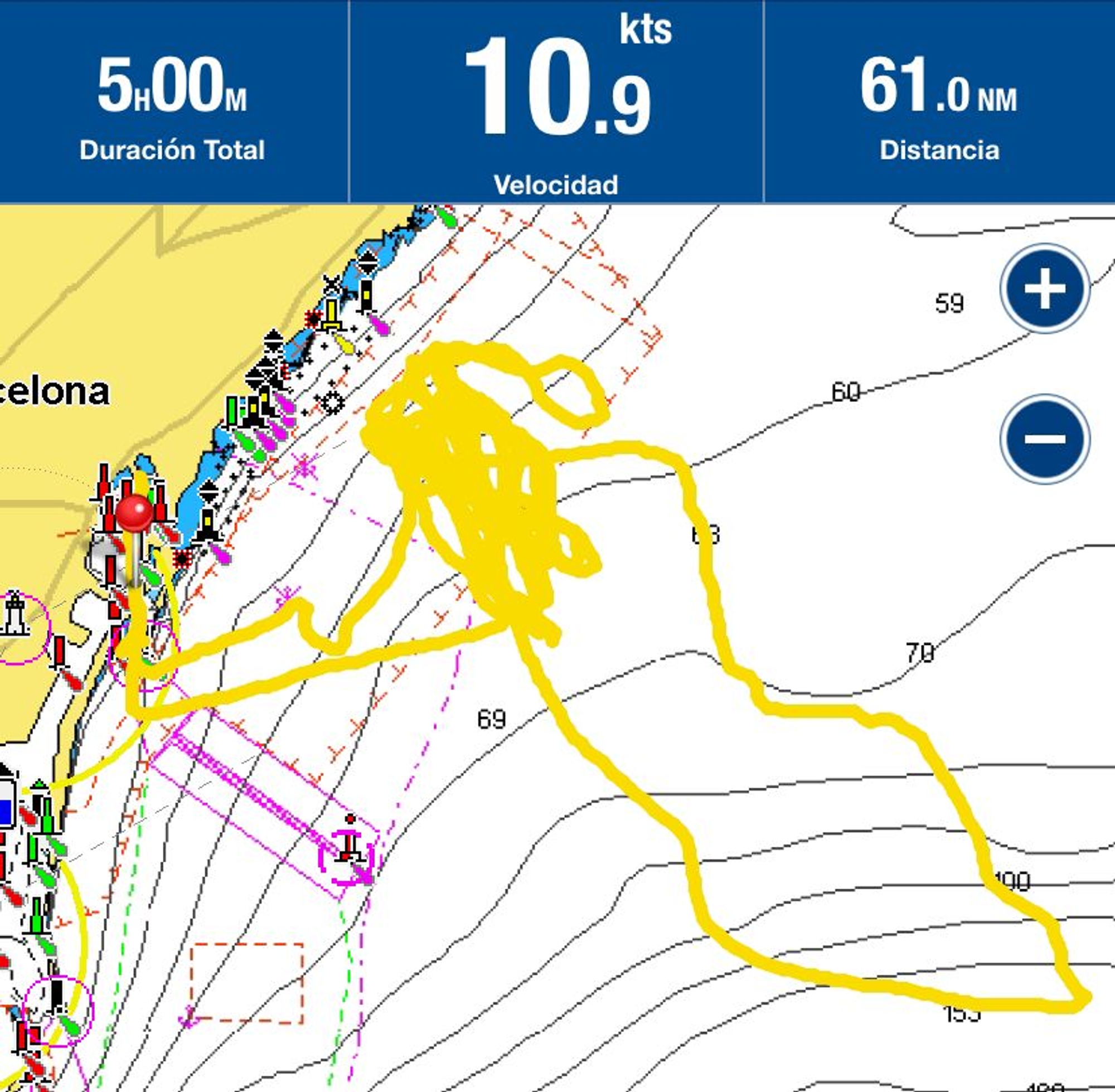This was a good day to be on a foiling yacht, sitting above the waves, not so good on a Chase Boat trying to keep up with three AC75s easily busting through 40 knots at times but Barcelona was beautiful and delivered in style. An offshore mistral brought in a building afternoon sea-breeze that whipped up the wave-forms as they approached the man-made sunken reefs that dot around the beachfront and made sailing more than challenging at times for INEOS Britannia, NYYC American Magic and Alinghi Red Bull Racing. Epic to watch and a real taste of things to come.
INEOS Britannia docked-out today just after 11.30am and elected to run with their smaller M2 mainsail whilst initially pairing it with a J2 hoping to gauge the cross-over to the vital J3 which they found in about 20 minutes of sailing as the breeze filled in from a fluky 8-10 knots into 11-13 knots. The sea-state was monstrous with wave heights recorded later in the afternoon of some 1.5 metres but it was a confused Barcelona swell that was testing the flight controllers and helms who were picking their lanes accurately.

Giles Scott was joined by Dylan Fletcher-Scott today on the helming duties and upwind on some initial blistering runs they looked co-ordinated through the tacks with high exit speeds. Downwind initially there were some shaky moments with the helms playing with very low-ride modes, dipping the bustle although the recon team reported that it didn’t seem to have too much effect on their boatspeed other than slightly high angles on the exit. As the session wore on, the British just got better and better and it’s a mark of their pure sailing talent just how quick they bring it all back together.

Over race laps, Britannia looked electric, and with the more controllable J4 jib up as the wind strength increased to 13-16 knots, they were able to build confidence through the gybing technique downwind whilst absolutely nailing the upwind. Britannia is a rapid and powerful platform with almost certainly the best skimming profile and clearly with plenty more to come in terms of how the team sail her, execute manoeuvres and keep the developments coming onstream. Fascinating challenge at the cutting edge of technology and design.

Speaking afterwards, Dylan Fletcher-Scott summed up the day and the sail plan, clearly an area of big focus now for the team to develop, saying: “It was a fantastic day here in Barcelona, think it looked a lot more uncomfortable in the chase boat than it was on the yacht, and yeah just another testing day and ticking off the checklist…it was nice to get the J4 up at the end there, the breeze eased down so we probably should have been on the J3, but it was good to see and check it all out and yeah we’ll be pushing it harder the next few days…we were on the smaller of the two mainsails that we have today which was really nice and was in range so I think the small mains are always nice but they’re not so good at the bottom end.”

For NYYC American Magic, they rolled out with some half-covers for the aft cockpits housing the recumbent cyclors so deep are the design team into maximising the aero effects of their super-slick, low-profile hull design. It’s becoming a feature, but even the cyclor pods have tell-tales and no doubt an angled camera to measure the effects – nothing is off the table in pursuit of aero perfection.

However, once again, reports came back of tech issues on Patriot, this time with one of the batteries playing up towards mid-afternoon and signalling the conclusion of the day. Previously though, they were on a ragged edge, pushing the boat hard over free laps and after some initial rather shaky runs with the boat looking all over the place, the trim team sorted the issue, flattened out the sails, rode lower on the foils and started to unleash Patriot’s undoubted potential at pace.

Tom Slingsby summed it up in interview afterwards saying: “That’s the first time we’ve sailed in that sort of sea state with Patriot. It was maybe a bit over a metre waves, but very sort of confused onshore sea state, so it was really just get our settings for that sort of sea state and what feels good and how the foils feel in a bit different ways, different angles, and I feel like we did that.”

And Tom continued: “When we first got out there it was really hard to get the balance of the boat right whether it was the foils or the sails, we were quite unstable the first half of the day and we made some changes and yeah we were able to get a little bit more stability especially downwind…you can easily get a little bit too top loaded and a little bit tippy in the top of the rig, we just tried to move the centre of effort down a little and see if we can get a bit of stability that way.”

Tom credited the new ‘Snoopy’ rudder as having a positive effect saying: “The new rudder it’s a bit longer, it’s our long rudder, and it felt pretty good actually like it almost saves you a couple of times there when you get a bit out of whack with heel or ride height and having that extra depth in the rudder can definitely save your ar*e.”

Speaking about the battery issue, Tom didn’t seem too concerned with these little gremlins on Patriot, saying: “We were having a few issues with batteries during the day, and so we probably weren’t out there as long as we would have liked, one of our batteries was just playing up a bit and we decided to play it safe and take that off so hence it is a bit shorter day than what we would usually have.”

Alinghi Red Bull Racing had an afternoon of two halves and effectively missed the glamour mid-afternoon breeze after breaking mainsail battens and being forced to return back to the base to affect a repair and check through everything. After docking-out at 1pm, and setting the legacy J3-3L which they have been using recently to save on the sail card, the sailing team went into some interesting training exercises involving 360s coming from both tacks. A mis-co-ordination between the trim and helm teams on the exit of a port ‘zero’ appeared to cause the damage and the team stopped immediately, knowing that things had broken up aloft.

After getting back to the dock at just after 2.30pm, many teams would have called it a day but not the Swiss whose superbly professional shore team swung into action and had the boat docked-out just 20 minutes later. Unfortunately, what greeted them out of the harbour were the remnants of the mistral and a very confused sea-state but the team persisted and after some more training ‘zeroes’ presumably to get foil data and improve co-ordination they went into a series of pre-starts having swapped their J4 up for a J3 as the wind began to falter. A couple of decent time-on-distance runs were seen into the line and then on the third start they went for a two-lap race with foiling manoeuvres difficult to execute as the wind went super-light.

Speaking afterwards, Olympic cyclist Théry Schir, the only dedicated ex-cyclist on the team summed the day up saying: “I would say it went well we had a small issue in the middle of the day and otherwise tricky conditions, the wind was very shifty, so it was definitely an interesting day to work on our technique…it was a coordination mistake that led to broken battens in the mainsail so we had to come back, change them and we were ready to go sailing again.”

Speaking specifically about his role as a cyclor and asked whether having a cycling background helped him, Théry was animated saying: “No definitely not, I think there’s a good reason why I’m the only cyclist because the rowers are much more powerful and heavier than a normal cyclist and it’s true that since I’ve arrived I have had to take a lot of weight, which is obviously not very good for cyclists, but on the boat it seems to be a good profile, you know heavy with a lot of power so I guess my cycling background helped me to be efficient on the boat but definitely I’m running after the rowers in terms of power.”

And talking about the training regime of a cyclist compared to a cyclor, Théry added: “The racing will be very different but most of my time I spend it on a bike inside, outside, on the boat, it doesn’t change a lot in terms of training but obviously the main goal is very different, but a race on the track the way I used to race like in the Madison, the Omnium or in the Olympics was maybe 10 to 15 minutes racing so I guess it’s pretty similar in terms of effort to what we face during the America’s Cup.”

Alinghi Red Bull Racing will be back out tomorrow with the W-Hotel tonight lit up in red. For NYYC American Magic it’s a maintenance day whilst for INEOS Britannia they are now off until Monday next week after making a late call. The recon team noted on-water log debris in the water as the team stopped sailing in to get a tow about a mile off from the harbour – but whether they hit anything is unconfirmed and no damage was sighted at lift out this evening. (Magnus Wheatley)
On-Water Recon Report: NYYC American Magic: American Magic rolled out Patriot at 09:45 and craned the yacht in at 10:15. Tell tales have been added to the deck around the crew area. It was later noted that a cover was added to cover half the port forward cyclor pod. This cover looked to be made of a canvas material, but it is possible it was solid. It also had tell-tales on the surface. The starboard cyclor pod was not visible from the recon spot at the base, so it is not confirmed whether there was also a cover on this side or not. Standard checks were carried out ahead of dock-out at 11:55, with the MN2-1 and J2-1 prepared for sailing.

Sailing commenced at 12:25, with 12-15 knots measured and a large sea state, made up of residual swell over 1m in height, from the mistral offshore, combined with wind chop. This is the first time Patriot has been sailed in such conditions, with the yacht initially looking unstable. Multiple adjustments at the clews of the sails were observed during the day, in order to bring centre of effort lower, as explained by Tom Slingsby in the post sailing interview. Stability improved and the team were able to perform more consistent manoeuvres, especially at the end of the day. The wind increased in the afternoon, with gusts measured up to 18 knots, as the team exchanged their J2 jib for the J3-1 after an hour on the water.
Most of the sailing today consisted of free laps around the set course, as the team dialled in boat settings and their technique in conditions new to the boat. A cyclor rotation and a second battery change were carried out at 14:20, after 50 minutes of active sailing. The first battery change occurred within the first 20 minutes of active sailing, but it was confirmed that the team was struggling with battery issues throughout the day. Sails were dropped by 15:20 and the team docked in at 16:20, after just under four hours on the water, of which 80 minutes were spent sailing. 35 manoeuvres were observed, 91% fully foiling.
On-Water Recon Report – Alinghi Red Bull Racing: The Swiss team rolled out their AC75 at 10:00. The boat was craned to the water at 10:20 and the team docked out at 13:00, after a one-hour delay, possibly due to unstable and uncertain weather conditions. The M2-1 was selected for the session, combined with the legacy J3-3L. Both sails were hoisted just before heading out of the port at 13:30.
High instability prevailed during the entire day, providing unstable south-south-easterly winds combined with a very disorganized sea state, that was the distinctive pattern of the session. Possibly the worse we have seen so far since the new AC75s have been launched.

The training started with an upwind-downwind, trying to deal with the unusual sea state. Then a short ten-minute break occurred. The agenda continued with some “zeros”, trying to achieve a stable boat with a good coordination in between flight controlling, sail trimming and course changes, in complicated seas. Unfortunately, on one of the turns, apparently one or more mainsail battens got broken. This forced Alinghi Red Bull Racing to proceed to lower both sails just out of the harbour and head back to the base on the tow for their replacement.
The Swiss team was back at the base at 14:37 and at 15:00 the second dock-out of the day happened with a new set of cyclors onboard, after having replaced the mainsail’s broken battens and checking the mast for minor damage. At 15:10 the same mainsail was re-hoisted, but this time combined with the J4-1. By 15:30 BoatOne was already back into training mode, performing a new upwind-downwind. Then further “zeros” were executed in both directions for fifteen minutes.
At 16:05 after a short ten-minute break, the AC75 headed to the race-course area, where marks had been laid and the pre-starts training got underway. A total of three sequences were accomplished, altering port and starboard tack entries and different movements inside the box.
Before the start of the third sequence, the J3-3L came up to replace the J4-1 in a dying breeze. Only the last sequence was not abandoned immediately after the start, which continued with a two-lap upwind-downwind, observing six tacks and gybes per leg, respectively. On the last lap, the AC75 struggled to achieve foiling manoeuvres in very light wind conditions, fully landing in most manoeuvres. After rounding the leeward gates, BoatOne continued to sail upwind towards the port.
Alinghi Red Bull Racing entered the harbour at 17:25, then sails got lowered and the team docked at 17:50, indicating the end of the day. Sebastian Peri Brusa – Recon on Alinghi Red Bull Racing
On-Water Recon Report – INEOS Britannia: The British team rolled out their AC75 at 09:00 and craned in at 09:30. Two new cameras were seen installed in the port foil. One was installed on the internal side on the low-pressure side of the foil and the other one was installed just in the middle part on the high-pressure side. The camera seen on the starboard foil was the same as in the last sailing session. LiDAR cameras for the mainsail and jib were also noted.

Dock out was at 11:35, with Britannia towed to the entrance of the harbour where sails were hoisted. Mainsail MN2 was hoisted and paired to a J2 jib. A wind of about 8-10 knots TWD 120 º @12:10 was blowing when they finished hoisting the sails and rapidly increased to 11-13 knots so after 20 minutes of sailing they had to stop and replace the J2 for the J3. Also, the sea state was quite tricky today (not for the AC75) as there was a steep and short wave-form that made it difficult to follow Britannia with the chase boat.
The MN-2 was seen today with a new tell-tale configuration on the top of the sail, on both layers. When sailing with the J3, a very long upwind and downwind was completed and then afterwards the team went into three race simulations using virtual marks. On the first race, two upwind-downwind laps were completed and on the two following races just one lap was completed. The wind increased to 13-16 knots TWD 120 @ 15:00 and the team decided to switch the J3 jib for a J4 jib.
We noticed today that the higher shroud from the leeward side was quite loose when sailing with jibs J3 and J4. The spreader could be seen moving in a forward-aft direction.
As per what Dylan Fletcher said in the interview after the sailing session, the team was trying different manoeuvres techniques today. Due to the waves, it was difficult to follow the boat and watch it properly, but it took our attention that some of the gybes were having a ‘wet’ and low exit as the hull was clearly touching the water but seemed not to affect their speed or course angle and were quite successful.
When they changed to the J4, in the first 30 minutes of sailing it looked to us that Britannia seemed to not be as clean at gybing as when they had J3 up. After those 30 minutes they started to nail the gybes.
Two more races were done with the J4 before calling the sailing session back to the base. After the last upwind-downwind race training Britannia started to sail back to port and suddenly stopped and dropped the sails. They were about 1 mile from the port entrance. We could see some wood logs around the area where they stopped and thought that maybe they touched one, but the crew looked calm and the chase boat towed Britannia in foiling mode back to the base so we thought the boat was fine and they decided to proceed with the towing for a security reason. We could see also the boat out of the water after the sailing session and no damage was noticed.
Some hours later we were informed that INEOS Britannia team is not sailing until next Monday (27th) when the next sailing day was initially programmed for tomorrow.
As a summary, the British team foiled today for about 150 minutes and did 21 tacks (19 fully foiling and 2 touch and go), 24 gybes (21 fully foiling, 2 touch and go, 1 touch down) through a long upwind-downwind and 5 upwind-downwind races. Two cyclor swaps were done (each one after 1 hour of effective sailing), batteries were replaced in the second cyclor swap and 3 jibs were hoisted and sailed today (J2, J3 and J4). Jose Luis Piñana – Ineos Britannia AC Recon






